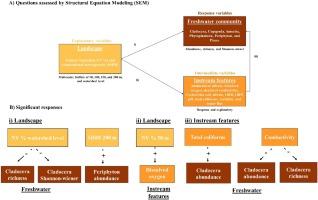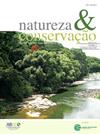Landscape structure coupled to instream features shape freshwater biodiversity in Cerrado agricultural landscapes
IF 3.5
2区 环境科学与生态学
Q1 BIODIVERSITY CONSERVATION
引用次数: 0
Abstract
Freshwater biodiversity is threatened at global scale, thus, understanding how it responds to anthropogenic interferences is critical, especially in regions where human disturbances have quickly altered natural ecosystems. Here, we address the effects of landscape structure in Brazilian Cerrado on freshwater community diversity of phytoplankton, periphyton, zooplankton and fish, and instream’s features (physicochemical and biological indicators of water quality, and water velocity), and the effects of instream’s features on freshwater community diversity. We analyzed the data at different spatial scales (50, 100, 150, and 200 m, and watershed level), using structural equation modeling. We found that percentage of native vegetation (%NV) at watershed level explained Cladocera’s abundance and Shannon-wiener with a negative relationship. Landscape compositional heterogeneity (SHDI) at 200 m explained Periphyton abundance with a positive relationship. %NV at 50 m explained dissolved oxygen with a positive relationship. Total coliforms explained Cladoceras’s abundance with a positive relationship. Conductivity explained Cladocera’s abundance and richness with a negative relationship. Our findings show that landscape changes are favoring some biological groups, which can lead to freshwater biotic homogenization. Thus, the unsustainable expansion of agriculture can compromise freshwater biodiversity and water quality in Cerrado.

景观结构与溪流特征的耦合塑造了塞拉多农业景观中的淡水生物多样性
淡水生物多样性在全球范围内受到威胁,因此,了解它如何对人为干扰作出反应至关重要,特别是在人类干扰迅速改变自然生态系统的地区。本文研究了巴西塞拉多地区景观结构对淡水浮游植物、周边植物、浮游动物和鱼类群落多样性的影响,以及河流特征(水质的理化和生物指标、流速)和河流特征对淡水群落多样性的影响。采用结构方程模型对不同空间尺度(50、100、150、200 m和流域)的数据进行分析。发现原生植被百分比(%NV)在流域水平上解释了Cladocera丰度与Shannon-wiener呈负相关关系。200 m的景观组成异质性(SHDI)与浮游植物丰度呈正相关。50 m处的%NV与溶解氧呈正相关。总大肠菌群与枝角龙的丰度呈正相关。电导率解释了枝角藻的丰度与丰富度呈负相关关系。我们的研究结果表明,景观变化有利于某些生物类群,这可能导致淡水生物同质化。因此,不可持续的农业扩张会损害塞拉多的淡水生物多样性和水质。
本文章由计算机程序翻译,如有差异,请以英文原文为准。
求助全文
约1分钟内获得全文
求助全文
来源期刊

Perspectives in Ecology and Conservation
Environmental Science-Nature and Landscape Conservation
CiteScore
7.80
自引率
4.30%
发文量
46
审稿时长
59 days
期刊介绍:
Perspectives in Ecology and Conservation (PECON) is a scientific journal devoted to improving theoretical and conceptual aspects of conservation science. It has the main purpose of communicating new research and advances to different actors of society, including researchers, conservationists, practitioners, and policymakers. Perspectives in Ecology and Conservation publishes original papers on biodiversity conservation and restoration, on the main drivers affecting native ecosystems, and on nature’s benefits to people and human wellbeing. This scope includes studies on biodiversity patterns, the effects of habitat loss, fragmentation, biological invasion and climate change on biodiversity, conservation genetics, spatial conservation planning, ecosystem management, ecosystem services, sustainability and resilience of socio-ecological systems, conservation policy, among others.
 求助内容:
求助内容: 应助结果提醒方式:
应助结果提醒方式:


